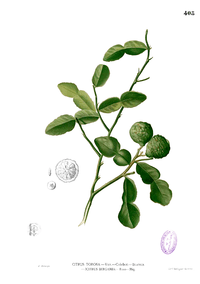Kaffir lime
| Citrus hystrix | |
|---|---|
 | |
| Citrus hystrix on sale | |
| Scientific classification | |
| Kingdom: | Plantae |
| (unranked): | Angiosperms |
| (unranked): | Eudicots |
| (unranked): | Rosids |
| Order: | Sapindales |
| Family: | Rutaceae |
| Genus: | Citrus |
| Species: | C. hystrix |
| Binomial name | |
| Citrus hystrix DC.[1] | |
| Synonyms[1] | |
|
List
| |
The kaffir lime (Citrus hystrix), sometimes referred to in English as the makrut lime (see below) or Mauritius papeda,[2] is a fruit native to tropical Asia including India, Nepal, Bangladesh, Thailand, Indonesia, Malaysia and the Philippines. It is used in Southeast Asian cuisine and the oil from it is used in perfumery.[3]
Common names
English: makrut lime; French:[4] citron combera, combava, citron ridé; Burmese: tau shauk hka: (တောရှောက်ခါး; pronounced: [tɔ̀.ʃaʊʔ.kʰá]); Indonesian/Malay: jeruk obat, jeruk purut, limau purut; Filipino: kabuyao or cabuyao; Khmer: krô:ch saë:ch;[4] Laos: mak khi hut (ໝາກຂີ້ຫູດ; pronounced [ma᷆ːk.kʰi᷆ː.hu᷆ːt]); Thai: ma krut (มะกรูด; pronounced [ma.krùːt]);[5][6] also known as combava, kieffer lime, makrut lime, or magrood lime. In South Indian cuisine it is used widely and is known as "narthangai".
The Oxford Companion to Food (ISBN 0-19-211579-0) recommends that the name kaffir lime be avoided in favor of makrut lime because Kaffir is an offensive term in some cultures and has no good justification for being attached to this plant.
Description


Citrus hystrix is a thorny bush, 6 to 35 feet (1.8 to 10.7 m) tall, with aromatic and distinctively shaped "double" leaves.[7][8] The makrut lime is a rough, bumpy green fruit. The green lime fruit is distinguished by its bumpy exterior and its small size (approx. 4 cm (2 in) wide).[8]
Uses


Cuisine
The rind of the makrut lime is commonly used in Lao and Thai curry paste, adding an aromatic, astringent flavor.[5] The zest of the fruit is used in creole cuisine to impart flavor in "arranged" rums in the Martinique, Réunion island and Madagascar. However, it is the hourglass-shaped leaves (comprising the leaf blade plus a flattened, leaf-like leaf-stalk or petiole) that are used most often in cooking. They can be used fresh or dried, and can be stored frozen. The leaves are widely used in Thai[5] and Lao cuisine (for dishes such as tom yum), and Cambodian cuisine (for the base paste "Krueng"). Makrut lime leaves are used in Vietnamese cuisine with chicken to add fragrance. They are also used when steaming snails to decrease the pungent odor while cooking. The leaves are also used in Indonesian cuisine (especially Balinese cuisine and Javanese cuisine), for foods such as Soto ayam, and are used along with Indonesian bay leaf for chicken and fish. They are also found in Malaysian and Burmese cuisines.[9] The juice is generally regarded as too acidic to use in food preparation. In Cambodia, the entire fruit is crystallized/candied for eating.[4]
Medicinal
The juice and rinds are used in traditional medicine in some Asian countries; the fruit's juice is often used in shampoo and is believed to kill head lice.[8]
Other uses
The juice finds use as a cleanser for clothing and hair in Thailand and very occasionally in Cambodia. Lustral water mixed with slices of the fruit is used in religious ceremonies in Cambodia.
Cultivation
Citrus hystrix is grown worldwide in suitable climates as a garden shrub for home fruit production. It is well suited to container gardens and for large garden pots on patios, terraces, and in conservatories.
Main constituents
The compound responsible for the characteristic aroma was identified as (–)-(S)-citronellal, which is contained in the leaf oil up to 80%; minor components include citronellol (10%), nerol and limonene.
From a stereochemical point of view, it is remarkable that makrut lime leaves contain only the (S) stereoisomer of citronellal, whereas its enantiomer, (+)-(R)-citronellal, is found in both lemon balm and (to a lesser degree) lemon grass, (note, however, that citronellal is only a trace component in the latter's essential oil).
Makrut lime fruit peel contains an essential oil comparable to lime fruit peel oil; its main components are limonene and β-pinene.[10][3]
See also
| Wikimedia Commons has media related to Citrus hystrix. |
- ×Citrofortunella mitis (Musk Lime)
- Citrus × depressa (Shikwasa, Hirami lemon)
- Citrus hybrids
References
- ↑ 1.0 1.1 "TPL, treatment of Citrus hystrix DC.". The Plant List; Version 1. (published on the internet). Royal Botanic Gardens, Kew and the Missouri Botanical Garden. 2010. Retrieved March 9, 2013.
- ↑ GRIN. "Citrus hystrix DC.". Taxonomy for Plants. National Germplasm Resources Laboratory, Beltsville, Maryland: USDA, ARS, National Genetic Resources Program. Retrieved December 7, 2014.
- ↑ 3.0 3.1 Ng, D.S.H.; Rose, L.C.; Suhaimi, H.; Mohamad, H.; Rozaini, M.Z.H.; Taib, M. (2011). "Preliminary evaluation on the antibacterial activities of Citrus hystrix oil emulsions stabilized by TWEEN 80 and SPAN 80". International Journal of Pharmacy and Pharmaceutical Sciences 3 (Suppl. 2).
- ↑ 4.0 4.1 4.2 Dy Phon Pauline, 2000, Plants Used In Cambodia, printed by Imprimerie Olympic, Phnom Penh
- ↑ 5.0 5.1 5.2 Loha-unchit, Kasma. "Kaffir Lime –Magrood". Retrieved December 7, 2014.
- ↑ Anderson, L. V. "Is the Name Kaffir Lime Racist?". Slate. Retrieved December 7, 2014.
- ↑ Kuntal Kumar (1 January 2008). The Original Organics Cookbook: recipes for healthy living. TERI Press. p. 54. ISBN 978-81-7993-155-4.
- ↑ 8.0 8.1 8.2 George Staples; Michael S. Kristiansen (1 January 1999). Ethnic Culinary Herbs: A Guide to Identification and Cultivation in Hawaiʻi. University of Hawaii Press. pp. 27–29. ISBN 978-0-8248-2094-7.
- ↑ Wendy Hutton, Wendy; Cassio, Alberto. Handy Pocket Guide to Asian Herbs & Spices. Singapore: Periplus Editions. p. 40. ISBN 0-7946-0190-1.
- ↑ Kasuan, Nurhani (2013). "Extraction of Citrus hystrix D.C. (Kaffir Lime) Essential Oil Using Automated Steam Distillation Process: Analysis of Volatile Compounds" (PDF). Malyasian Journal of Analytical Sciences 17 (3): 359–369.
